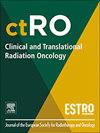当日磁共振引导的单部分立体定向体放射治疗疼痛的非脊柱骨转移-一项单中心研究(“骨注射”)
IF 2.7
3区 医学
Q3 ONCOLOGY
引用次数: 0
摘要
有证据表明,高剂量单次立体定向放射治疗(SF-SBRT)治疗疼痛性非脊柱骨转移(NSBMs)是有效的。这项研究(“BONE SHOT”)评估了当天磁共振引导(MRg)计划和SF-SBRT递送的可行性,记录了毒性并评估了治疗转移性NSBMs患者的疗效。材料和方法具有疼痛(在0-10数值评定量表(NRS)中疼痛≥3/10分)和放射学证实的实体器官恶性肿瘤NSBMs的患者符合本前瞻性获得性单中心研究的条件。患者通过MR-Linac (ViewRay®)接受MRg-SF-SBRT,当日咨询、同意、计划和治疗。记录停药率、手术时间、急性毒性和疼痛反应。结果在2019年6月至2020年6月期间,13例15例非nsbm患者接受了每个方案的治疗。患者平均年龄64岁(范围30-87岁);最常见的原发肿瘤是胃肠道恶性肿瘤(38.5%);最常见的治疗部位是骨盆(53.3%)。所有工作流程均按计划完成。轮廓、计划和分娩的中位手术时间为65分钟(范围57-112分钟)。治疗耐受性良好;一名患者发展出“疼痛感”;未见3级以上毒性反应。在SBRT后一周,总体和完全疼痛缓解率分别为73.3%和20.0%,在SBRT后四周分别为66.7%和53.3%;治疗前疼痛评分中位数为6分,4周时疼痛评分中位数降低5分(P = 0.0028)。结论NSBMs当天MRg-SF-SBRT工作流程是可行的,安全的,初步结果显示有希望的疗效,值得未来的试验研究该干预措施。本文章由计算机程序翻译,如有差异,请以英文原文为准。
Same-Day Magnetic Resonance-Guided Single-Fraction Stereotactic Body Radiation Therapy for Painful Non-Spine Bone Metastases – A Single-Center Study (“BONE SHOT”)
Introduction and background
There is evidence for efficacy of high-dose single-fraction stereotactic body radiotherapy (SF-SBRT) for painful non-spine bone metastases (NSBMs). This study (“BONE SHOT”) assessed feasibility of same-day magnetic resonance-guided (MRg) planning and SF-SBRT delivery, recorded toxicity and assessed efficacy for treating metastatic patients with NSBMs.
Materials and methods
Patients with painful (≥3/10 points on a 0–10 numeric rating scale (NRS) for pain) and radiologically confirmed NSBMs from solid organ malignancies were eligible for this prospectively acquired, single-center study. Patients received MRg-SF-SBRT via MR-Linac (ViewRay®) with same-day consultation, consent, planning and treatment. Drop-out rate, procedure times, acute toxicity and pain response were recorded.
Results
Between June 2019 and June 2020, 13 patients with 15 NSBMs were treated per protocol. Mean patient age was 64 (range, 30–87) years; most common primary cancer was gastrointestinal malignancies (38.5 %); most commonly treated site was pelvis (53.3 %). All workflows were completed as planned. Median on-table time for contouring, planning and delivery was 65 (range, 57–112) minutes. Treatments were well tolerated; one patient developed “pain flair”; no grade ≥ 3 toxicities were registered. At one week following SBRT, overall and complete pain response rates were 73.3 % and 20.0 %, respectively, which evolved to 66.7 % and 53.3 % at four weeks after SBRT; median pre-treatment pain score was 6 points, which was reduced by a median of 5 points (P = 0.0028) at four weeks.
Conclusion
The same-day MRg-SF-SBRT workflow for NSBMs was feasible, safe, and preliminary results indicate promising efficacy, warranting future trials investigating this intervention.
求助全文
通过发布文献求助,成功后即可免费获取论文全文。
去求助
来源期刊

Clinical and Translational Radiation Oncology
Medicine-Radiology, Nuclear Medicine and Imaging
CiteScore
5.30
自引率
3.20%
发文量
114
审稿时长
40 days
 求助内容:
求助内容: 应助结果提醒方式:
应助结果提醒方式:


